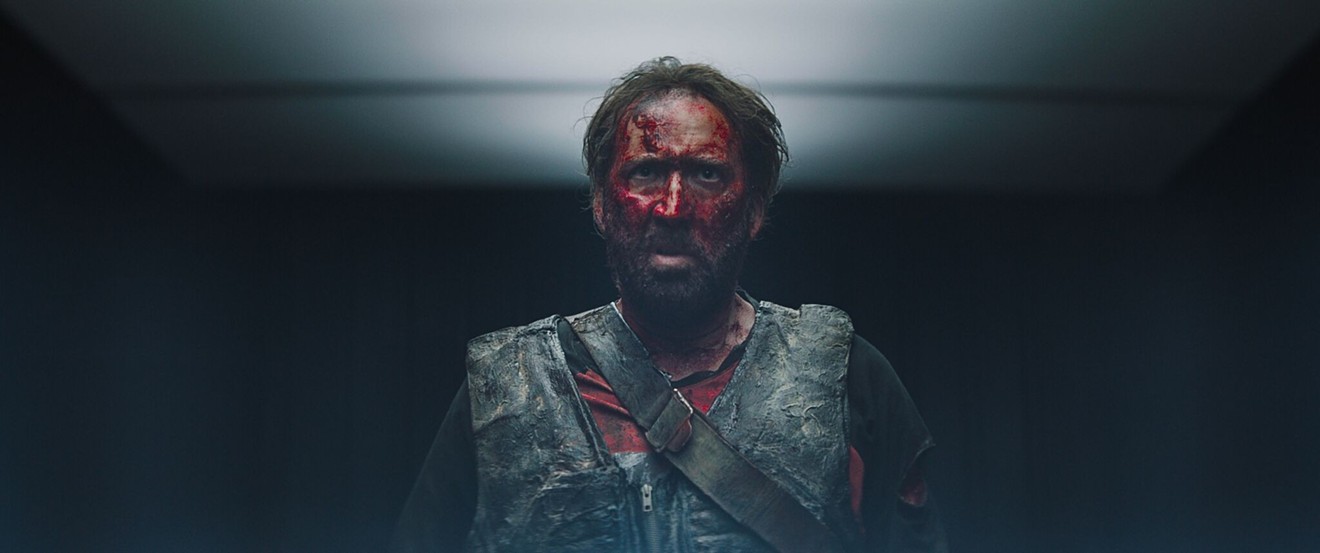It’s heartening to see someone living their dream. With his second feature, Panos Cosmatos, the VHS-mad director of the hypnotic horror lulu Beyond the Black Rainbow, has scored the ultimate video-addict coup. He has convinced Nicolas Cage to star in his horror flick. And, like any true fan of grisly midnight movies, Cosmatos has developed, over his life, a whole bucket list of ridiculous feats he hoped he’d live long enough to see Cage perform onscreen. Chainsaw fighting? Telling a knock-knock joke? Sticking his face right into a geyser of gore that simply gushes, on and on, like a busted fire hydrant? Cosmatos gives us all that and so much more. His Mandy is an entrancing slaughterhouse of a revenge flick that grooves along on the baddest of bad vibes. It achieves the ecstatic through arterial spray, through faces melting and flesh ripped by barbed wire, through the way Cage’s eyes, at times, go wide and round as lotto balls. It’s Cosmatos who has won the lottery, though — and you, too, if all this Cage is your cup of crazy.
It’s not fully mine, to be honest, and thrilled as I often was by it, I at times found Mandy’s grisly beauty depleting, to see such exquisite technical command applied to the same old gotta-kill-’em-all storytelling. Cage’s character is out for blood — and blood and blood and blood and blood — for the same cheap-ass reason most movie heroes are out for blood: They killed his woman. They in this case is a folk-rock Jesus death cult with members who favor lengthy nude sermons and the unleashing of leather-clad, demon-armored murderers with rusty nails protruding from their silhouettes. (Just watching Mandy, I found myself craving a tetanus shot.) The woman is Andrea Riseborough’s Mandy Bloom, who, in a break with thriller tradition, at least gets scenes where she has more to do than just give the hero his reasons for heroism. Long, languorous stretches of the film’s first half find her and Cage’s character, beardo lumberjack Red Miller, lounging around their remote cabin, talking about planets and comic book characters while Cosmatos and director of photography Benjamin Loeb layer vivid, engrossing tints and textures over the frame.
But Mandy dazzled away my objections. Like Black Rainbow, the film is set in 1983, and Cosmatos and crew lovingly expand on the aesthetics of that year’s video-store horror rentals. In its hellscapes and bloodlettings, its tense home invasion and its occasionally comic splattery, Mandy at times plays like the movie horror fans were imagining they might someday get while they were watching, like, Chopping Mall. That’s excepting, of course, the relative slowness, the favoring of atmosphere over plot or fake-out scares. As in Beyond the Black Rainbow, Mandy is a mood piece — at first, at least. Scored to Johann Johannsson’s washes of electro-ambient sound, the opening scenes stir a stoned, cosmic warmth, a sense of these two characters isolated from the world but fully inhabiting each other. But the good trip soon sours with the arrival of the Children of the New Dawn, led by Linus Roache’s speechifyin’ Jeremiah, who dispatches armored killers on ATVs to bring him Mandy.
Cosmatos delivers (as fans say) on the blood and guts, on cathartic slaughter, on the disreputable pleasure of watching a bereaved hero regard a new weapon and envision nasty uses for it. (At one high point, Cage’s lumberjack forges his own fantasy-movie ax, a wicked silver blade right out of Krull.) And it wouldn’t be a Cage classic without scenes of the star suffering gravely and howling nonsense with the outsize conviction that critic Outlaw Vern has dubbed Cage’s “mega-acting.” But the film’s chief pleasure is its layered and lurid look, that electro-hell cinematography that suggests both the fantastic — the covers of the late ‘70s science fiction paperbacks beloved by Red and Mandy — but also more everyday terrors, like the brake lights of some mean bastard’s truck out on the most barren of dirt roads.
That malevolent crimson lords over Mandy, as if the sky — or the screen itself — is bleeding neon. Then, in the moments when other filmmakers might give us, say, a story, Cosmatos and Co. plunge us into that nightmare of red, utilizing bursts of disturbing animation, insert shots of flames or armored fiends, first-person dives into bizarre environments. Behold the slow arrival of those killers on their ATVs, the headlights appearing like the eyes and mouths of skulls in the mist. And then, if that’s not grabbing you, Cage will soon shout some glorious gob of crazy. If they have to keep making movies about dudes killing dudes to avenge a woman, at least let them be this raving and beautiful.
[
{
"name": "Air - MediumRectangle - Inline Content - Mobile Display Size",
"component": "18855504",
"insertPoint": "2",
"requiredCountToDisplay": "2"
},{
"name": "Editor Picks",
"component": "17105533",
"insertPoint": "4",
"requiredCountToDisplay": "1"
},{
"name": "Inline Links",
"component": "18349797",
"insertPoint": "8th",
"startingPoint": 8,
"requiredCountToDisplay": "7",
"maxInsertions": 25
},{
"name": "Air - MediumRectangle - Combo - Inline Content",
"component": "17105532",
"insertPoint": "8th",
"startingPoint": 8,
"requiredCountToDisplay": "7",
"maxInsertions": 25
},{
"name": "Inline Links",
"component": "18349797",
"insertPoint": "8th",
"startingPoint": 12,
"requiredCountToDisplay": "11",
"maxInsertions": 25
},{
"name": "Air - Leaderboard Tower - Combo - Inline Content",
"component": "17105535",
"insertPoint": "8th",
"startingPoint": 12,
"requiredCountToDisplay": "11",
"maxInsertions": 25
}
]












